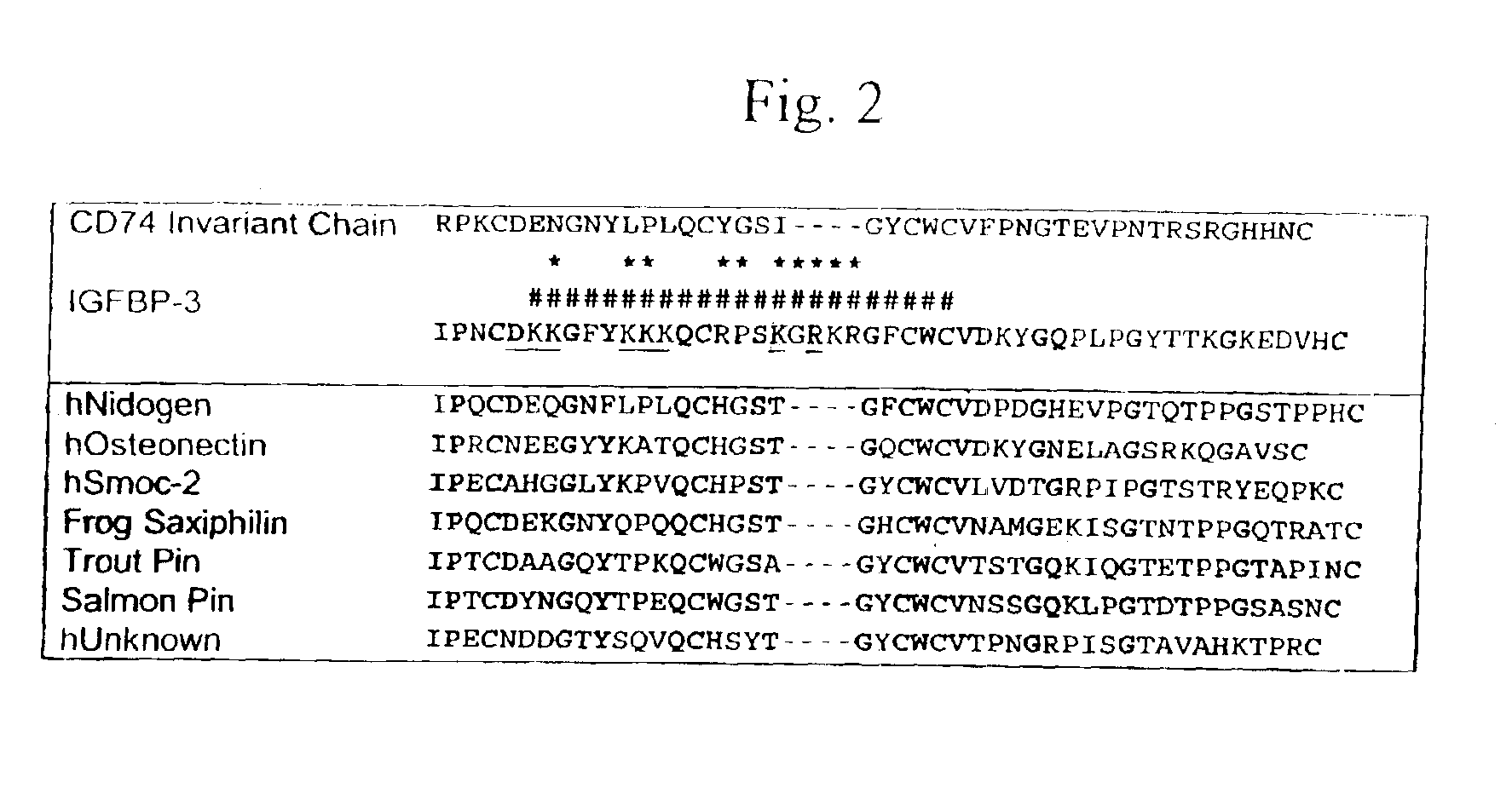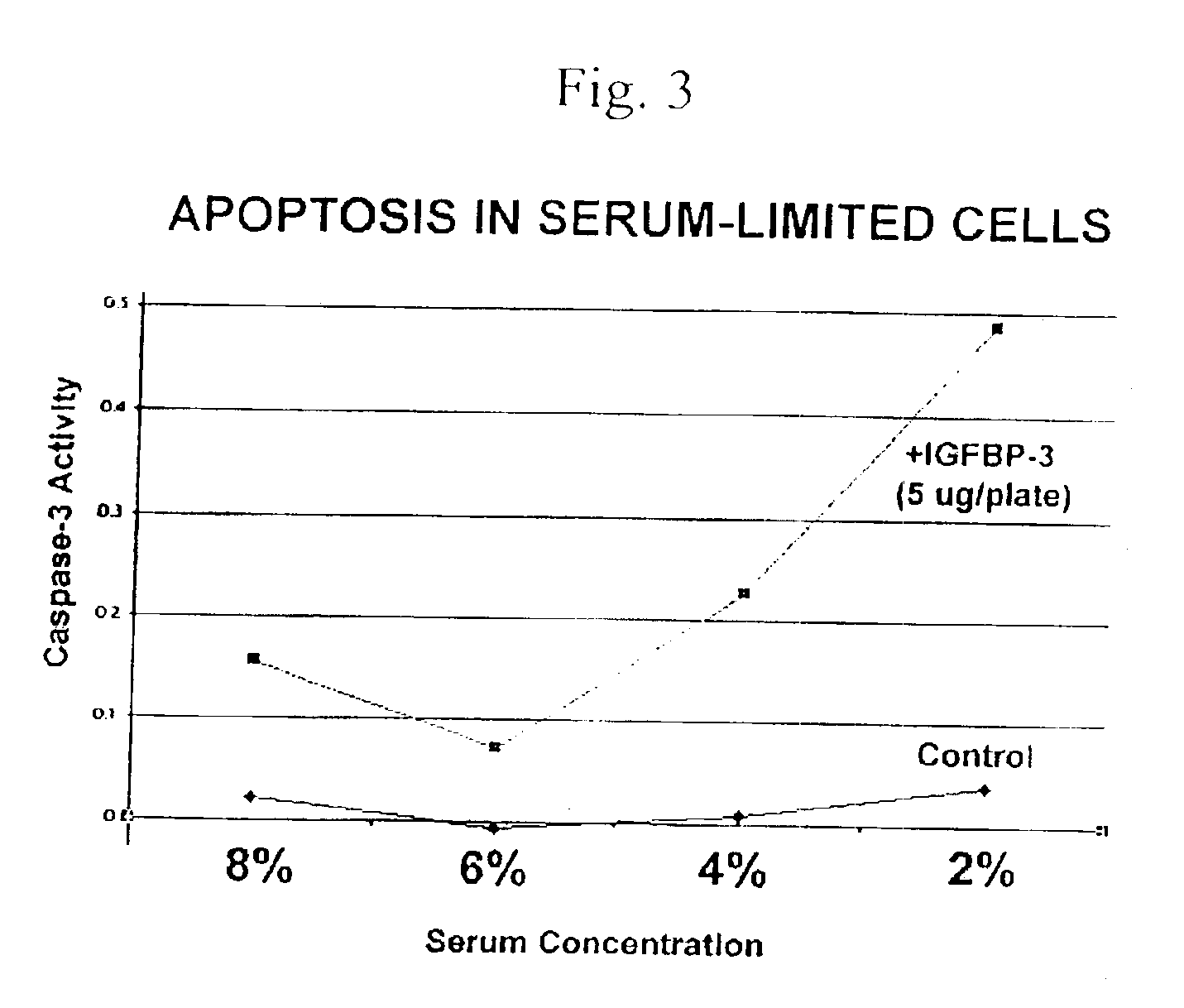IGF-binding protein-derived peptide or small molecule
a technology of igf-binding protein and small molecule, which is applied in the field of peptides or small molecules, can solve the problems of high affinity binding to any of these ligands, the precise location of this putative protease inhibitor domain has not yet been described, and the dose-limiting toxicity of myelosuppression is often the problem, so as to reduce tumor invasiveness, reduce local, regional and metastatic spread of tumors, and reduce tumor invasiveness
- Summary
- Abstract
- Description
- Claims
- Application Information
AI Technical Summary
Benefits of technology
Problems solved by technology
Method used
Image
Examples
example 1
Treatment of Nutritionally Stressed HEK293 Kidney Cells with IGFBP-3
[0150]Human embryonal kidney 293 (HEK293) cells were grown in Dulbecco's Modified Eagle Medium (D-MEM) supplemented with fetal calf serum at 2%, 4%, 6%, or 8%. When the cells reached 80-85% confluency (cell titer approximately 2.1×106 cells per plate), 5 μg of IGFBP-3 or buffer control was added to each plate. The cells were incubated at 37° C. overnight. The next day the medium was removed and the cells were rinsed with trypsin-EDTA (0.25% trypsin, 1 mM EDTA) plus 1× phosphate buffered saline. The cells were centrifuged and the supernatant was removed. ApoAlert caspase-3 assay kit from Clontech Inc (Palo Alto, Calif.) was used to measure apoptosis. The cells were resuspended in 50 μl of chilled cell lysis buffer and incubated on ice for 10 minutes. The resulting cell, lysates were centrifuged at 14000 rpm in a Beckman microcentrifuge for 3 minutes at 4 C. The supernatant was transferred to new tubes and 50 μl of 2×...
example 2
Identification of Pro-Apoptotic Peptide Sequences
[0151]As shown in FIG. 4A and disclosed in co-owned U.S. patent application Ser. No. 09 / 956,508, IGFBP-3 has pro-apoptotic activity. Peptides derived from IGFBP-3 were tested for pro-apoptotic activity essentially as described in Example 1.
[0152]The peptides tested are described in Table 1 (peptides marked with an asterisk include a hexahistidine tag).
[0153]
TABLE 1PeptideFIG. 4B referenceControl (no peptide)Arh (N109D)-IGFBP-3Bglycosylated CHO-derived rhIGFBP-3CrhIGFBP-3 / rhIGF-I complexDrhIGFBP-3 / rh(Y60L)-IGF-I complexE*(KKGHAKDSQRYKVDYESQS)-gfpF(SEQ ID NO:6)*(KKGFYKKKQCRPSKGRKRGFCW)-gfpG(SEQ ID NO:7)DKKGFYKKKQCRPSKGRKRGFCWH(SEQ ID NO:1)QCRPSKGRKRGFCWI(SEQ ID NO:3)
[0154]Data from this experiment, summarized in FIG. 4B, demonstrated, for the first time, that it was possible to generate IGFBP-3-derived peptides exhibiting greater pro-apoptotic activity (on a weight basis) than intact IGFBP-3 itself. Comparing the pro-apoptotic activity ...
example 3
Metal-Binding Properties of IGFBP-3 and Derivative Peptides
[0155]As shown in FIG. 5, intact IGFBP-3 binds immobilized nickel and zinc and can be eluted from the resin with 60 mM imidazole. This previously unknown property of IGFBP-3 is intriguing and has a number of practical implications among which the ability to capture products using immobilized metal affinity (IMAC) resins leads to a number of potential applications in therapeutic, high-throughput discovery, and other research arenas.
[0156]FIG. 5 shows SDS-PAGE results from IMAC purification of IGFBP-3 using Ni++ (panel a) and Zn++ (panel b) IMAC. IGFBP-3 bound both IMAC resins effectively.
[0157]We further tested the ability of IGFBP-3-derived sub-domains and peptides to bind metal. As shown in Example 5, below, a defined fragment of IGFBP-3 generated in vivo can be captured on IMAC. Two short peptides were passed through a Ni-His-Bind column:
[0158]
(SEQ ID NO:1)Peptide 1:(H2N) . . . DKKGFYKKKQCRPSKGRKRGFCW . . . (COOH);(SEQ ID ...
PUM
| Property | Measurement | Unit |
|---|---|---|
| Dimensionless property | aaaaa | aaaaa |
| Fraction | aaaaa | aaaaa |
| Fraction | aaaaa | aaaaa |
Abstract
Description
Claims
Application Information
 Login to View More
Login to View More - R&D
- Intellectual Property
- Life Sciences
- Materials
- Tech Scout
- Unparalleled Data Quality
- Higher Quality Content
- 60% Fewer Hallucinations
Browse by: Latest US Patents, China's latest patents, Technical Efficacy Thesaurus, Application Domain, Technology Topic, Popular Technical Reports.
© 2025 PatSnap. All rights reserved.Legal|Privacy policy|Modern Slavery Act Transparency Statement|Sitemap|About US| Contact US: help@patsnap.com



